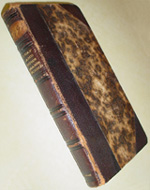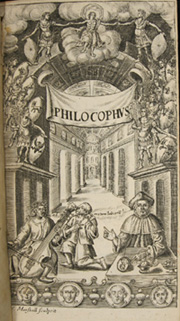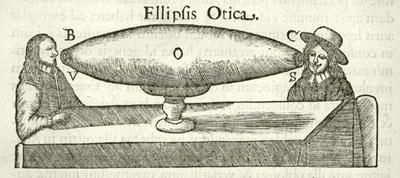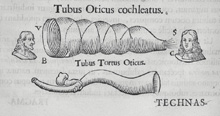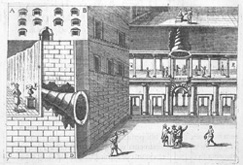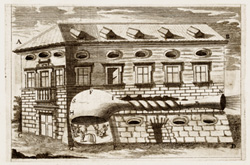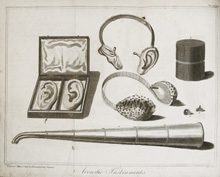Rare Books on Deafness, Hearing, and Hearing Devices
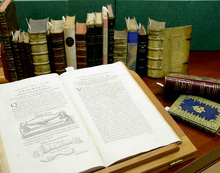 |
The CID-Max A. Goldstein Collection in Speech and Hearing emphasizes works in otology, otorhinolaryngology, speech pathology, and deaf education. Originally assembled by Dr. Max Aaron Goldstein, founder of the Central Institute for the Deaf, the collection was donated to the Washington University School of Medicine Library in 1977. This collection of about 920 volumes of rare and classic books dating from the 15th century on otorhinolaryngology has been called one of the most comprehensive collections in the country for the period 1700 to 1900. Early works on physiognomy, phrenology, and chiromancy are also included in the collection.
Selected rare and classic works from the collection pertaining to means for conveying of sound and amplification of sound are presented in chronological order.
John Bulwer (fl. 1644-1662). Philocophus: or, The Deafe and Dumbe Mans Friend. Exhibiting the philosophicall verity of that subtile art, which may inable one with an observant eie, to heare what any man speaks by the moving of his lips . . . London: Printed for Humphrey Moseley, 1648.
“. . . we have discovered sufficient ground to raise a new Art upon, directing how to convey intelligible and articulate sounds another way to the brain than by the eare or eye; shewing that a man heare as well as speake with his mouth.”
Francis Bacon (1561-1626). Sylva sylvarum. Frankfurt am Main: Schonwetteri, 1665.
| Bacon’s work describes one of the earliest known references to ear trumpets and elaborated on the principle of speaking tubes with comparisons to “ear spectacles.” | 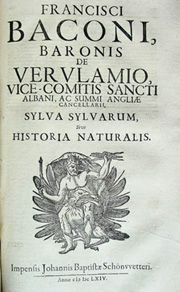 |
| Title page of Sylva sylvarum |
|---|
Athanasius Kircher (1602-1680). Phonurgia nova sive conjugium mechanico-physicum artis & naturae paranymta phonosophia concinnatum. Kempten: Rudolph Dreherr, 1673.
Kircher was a Jesuit priest from Germany and later became a Professor of Mathematics at the College of Rome. A true polymath, Kircher was a mathematician, physicist, Orientalist, musician, and physician. While studying at Rome, Kircher built a brass tube leading from his room down to the watchman at the gate to allow for communication of messages. Kircher’s research on sound led him to believe that sound was the earthly counterpoint to heavenly light. To demonstrate this concept, Kircher developed a ‘hearing lens’ or ‘speaking trumpet’ which made distant sounds seem close, just as a telescope does with distant sights.
Phonurgia nova was the first known published book to deal with the nature of sound, acoustics and music. The profusely illustrated folio contains the earliest known complete illustrations of devices to convey and amplify sound among the architectural and engineering products related to sound.
Illustrations of speaking tubes and trumpets in Phonurgia nova. The “Ellipsis Otica” (above) is one of the oldest illustrations of a hearing aid.
 |
 |
This illustration shows how sound amplification principle was used in dome shaped construction to amplify sound in council halls where it was used to transmit sound to distant points. |
The illustration above left shows how a person in a room inside a building could eavesdrop on people talking in the street outside by means of a sound receiver. Likewise, the illustration above right shows how music being played inside a building could be transmitted and enjoyed by those outside the building.
| This illustration shows how sound could be reflected off an object (in this case, a building), and heard by someone who was unable to see the source of the sound. |  |
Christoph Stephanus Kazaver. De tuba stentorea: Germ. Das Sprach Rohr . . . praeside Dn. M. Ioh. Henrico Mullero . . . / publico eruditorum examini subjiciet Christoph. Stephanus Kazaver. Altdorf: Typis Iod. Guil. Kohlesii, 1713.
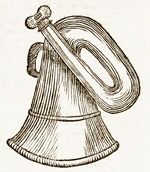 |
De tuba stentorea focuses on the amplification and transmission of sound. The device on the left is similar to a musical instrument; the illustration on the right is of a sound amplification device. | 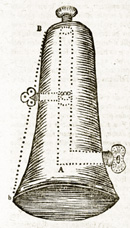 |
John Harrison Curtis (1778-ca.1860). Treatise on the physiology and diseases of the ear; containing a comparative view of its structure and functions, and of its various diseases, arranged according to the anatomy of the organ, or as they affect the external, the intermediate, and the internal ear. London: Sherwood, Neely and Jones, 1817.
Curtis served as the aurist to the English royalty, authored a number of publications on the physiology and diseases of the ear and invented the Curtis Acoustic Chair. In A treatise on the physiology and diseases of the ear, Curtis stated that patients preferred the French silver ear hearing devices as they were less conspicuous and weighed less than the German silver ears.

